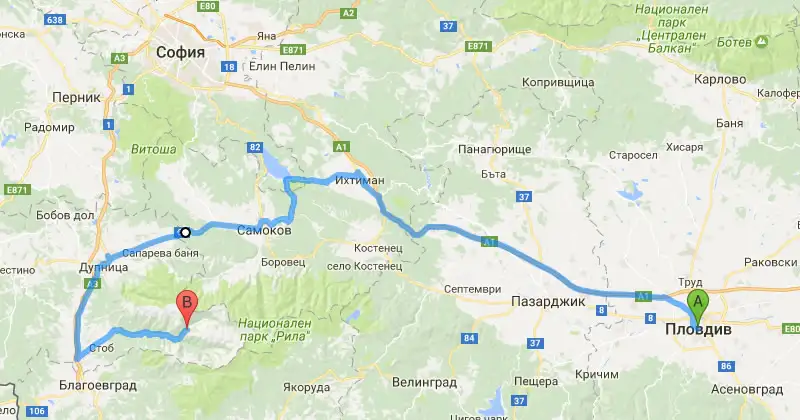You need a transfer from Plovdiv to Rila Monastery and back?
One day private trip to Rila monastery and back with a car!
For actual prices CLICK HERE
Just call us!
Professional taxi shuttles in Bulgaria!
Private transfer from Plovdiv to Rila Monastery and back. If necessary, we will send more cars. We will organize everything for the taxi shuttle.
If you need a taxi to meet you at Plovdiv Airport and take you to Rila Monastery or to another city in the country, you can trust us. At the agreed date and time of arrival, a qualified professional driver speaking English will wait for you with a plate with your name. He will take you safely to the hotel, the office or the address where you will stay.
The purpose of the transfer offer is to provide you with safe and comfortable travel to the destination.
Transfer time from Plovdiv to Rila Monastery (or Rila Monastery to Plovdiv) is about 3 hours and a half. Rila Monastery is located 230 km from Plovdiv and the trip is almost entirely on the secondary way.
The Monastery of Saint Ivan of Rila, better known as the Rila Monastery (Bulgarian: Рилски манастир, Rilski manastir) is the largest and most famous Eastern Orthodox monastery in Bulgaria. It is situated in the southwestern Rila Mountains, 117 km (73 mi) south of the capital Sofia in the deep valley of the Rilska River at an elevation of 1,147 m (3,763 ft) above sea level, inside of Rila Monastery Nature Park. The monastery is named after its founder, the hermit Ivan of Rila (876 - 946 AD), and today houses around 60 monks.
Founded in the 10th century, the Rila Monastery is regarded as one of Bulgaria's most important cultural, historical and architectural monuments and is a key tourist attraction for both Bulgaria and Southern Europe. In 2008 alone, it attracted 900,000 visitors. The monastery is depicted on the reverse of the 1 lev banknote, issued in 1999.
It is traditionally thought that the monastery was founded by the hermit St. Ivan of Rila, whose name it bears, during the rule of Tsar Peter I (927-968). The hermit actually lived in a cave without any material possessions not far from the monastery's location, while the complex was built by his students, who came to the mountains to receive their education.
Ever since its creation, the Rila Monastery has been supported and respected by the Bulgarian rulers. Large donations were made by almost every tsar of the Second Bulgarian Empire up until the Ottoman Conquest, making the monastery a cultural and spiritual centre of Bulgarian national consciousness that reached its apogee from the 12th to the 14th century.
The Rila Monastery was reerected at its present place by Hrelyu, a feudal lord, during the first half of the 14th century. The oldest buildings in the complex date from this period -— the Tower of Hrelja (1334–1335) and a small church just next to it (1343). The bishop's throne and the rich-engraved gates of the monastery also belong to the time. However, the arrival of the Ottomans in the end of the 14th century was followed by numerous raids and a destruction of the monastery in the middle of the 15th century.
Thanks to donations by the Sultana Mara Branković, the Russian Orthodox Church and the Rossikon monastery of Mount Athos, the Rila Monastery was rebuilt in the end of the 15th century by three brothers from the region of Dubnica (Dupnica). With Sultana Mara Branković's influence Ivan of Rila's relics were moved from Trnovo into the new complex in 1469.
The complex acted as a depository of Bulgarian language and culture in the ages of foreign rule. During the time of the Bulgarian National Revival (18th-19th century), it was destroyed by fire in 1833 and then reconstructed between 1834 and 1862 with the help of wealthy Bulgarians from the whole country, under the famous architect Alexi Rilets. The erection of the residential buildings began in 1816, while a belfry was added to the Tower of Hrelyu in 1844. Neofit Rilski founded a school in the monastery during the period. The monastery is known as being one of the hideouts of Bulgarian revolutionaries such as Vassil Levski, Gotse Delchev, Peyo Yavorov, etc. The monastery complex, regarded as one of the foremost masterpieces of Bulgarian National Revival architecture, was declared a national historical monument in 1976 and became a UNESCO World Heritage Site in 1983. Since 1991 it has been entirely subordinate to the Holy Synod of the Bulgarian Orthodox Church.
On 25 May 2002, Pope John Paul II visited Rila monastery during his pilgrimage to Bulgaria. He was greeted by the Monastery's igumen, Bishop Ioan, who had been an observer at the Second Vatican Council.





















